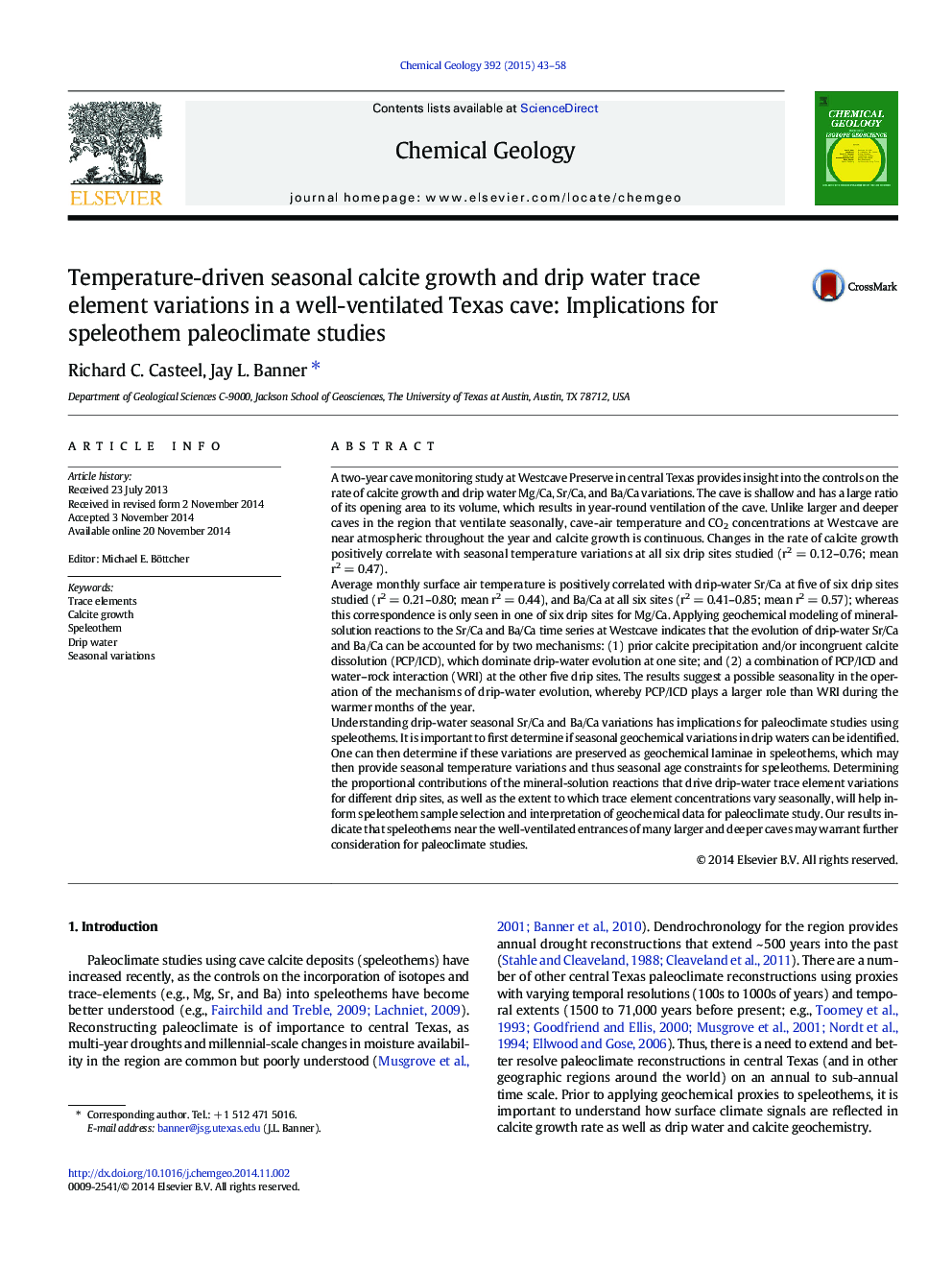| کد مقاله | کد نشریه | سال انتشار | مقاله انگلیسی | نسخه تمام متن |
|---|---|---|---|---|
| 6436537 | 1637580 | 2015 | 16 صفحه PDF | دانلود رایگان |
- The study cave is well-ventilated and cave-air is similar to surface atmosphere.
- Calcite growth rate positively correlates with seasonal temperature variations.
- Surface air temperature is positively correlated with drip-water Sr/Ca and Ba/Ca.
- Drip water Sr/Ca and Ba/Ca may be preserved as geochemical laminae in speleothems.
A two-year cave monitoring study at Westcave Preserve in central Texas provides insight into the controls on the rate of calcite growth and drip water Mg/Ca, Sr/Ca, and Ba/Ca variations. The cave is shallow and has a large ratio of its opening area to its volume, which results in year-round ventilation of the cave. Unlike larger and deeper caves in the region that ventilate seasonally, cave-air temperature and CO2 concentrations at Westcave are near atmospheric throughout the year and calcite growth is continuous. Changes in the rate of calcite growth positively correlate with seasonal temperature variations at all six drip sites studied (r2Â =Â 0.12-0.76; mean r2Â =Â 0.47).Average monthly surface air temperature is positively correlated with drip-water Sr/Ca at five of six drip sites studied (r2Â =Â 0.21-0.80; mean r2Â =Â 0.44), and Ba/Ca at all six sites (r2Â =Â 0.41-0.85; mean r2Â =Â 0.57); whereas this correspondence is only seen in one of six drip sites for Mg/Ca. Applying geochemical modeling of mineral-solution reactions to the Sr/Ca and Ba/Ca time series at Westcave indicates that the evolution of drip-water Sr/Ca and Ba/Ca can be accounted for by two mechanisms: (1) prior calcite precipitation and/or incongruent calcite dissolution (PCP/ICD), which dominate drip-water evolution at one site; and (2) a combination of PCP/ICD and water-rock interaction (WRI) at the other five drip sites. The results suggest a possible seasonality in the operation of the mechanisms of drip-water evolution, whereby PCP/ICD plays a larger role than WRI during the warmer months of the year.Understanding drip-water seasonal Sr/Ca and Ba/Ca variations has implications for paleoclimate studies using speleothems. It is important to first determine if seasonal geochemical variations in drip waters can be identified. One can then determine if these variations are preserved as geochemical laminae in speleothems, which may then provide seasonal temperature variations and thus seasonal age constraints for speleothems. Determining the proportional contributions of the mineral-solution reactions that drive drip-water trace element variations for different drip sites, as well as the extent to which trace element concentrations vary seasonally, will help inform speleothem sample selection and interpretation of geochemical data for paleoclimate study. Our results indicate that speleothems near the well-ventilated entrances of many larger and deeper caves may warrant further consideration for paleoclimate studies.
Journal: Chemical Geology - Volume 392, 21 January 2015, Pages 43-58
